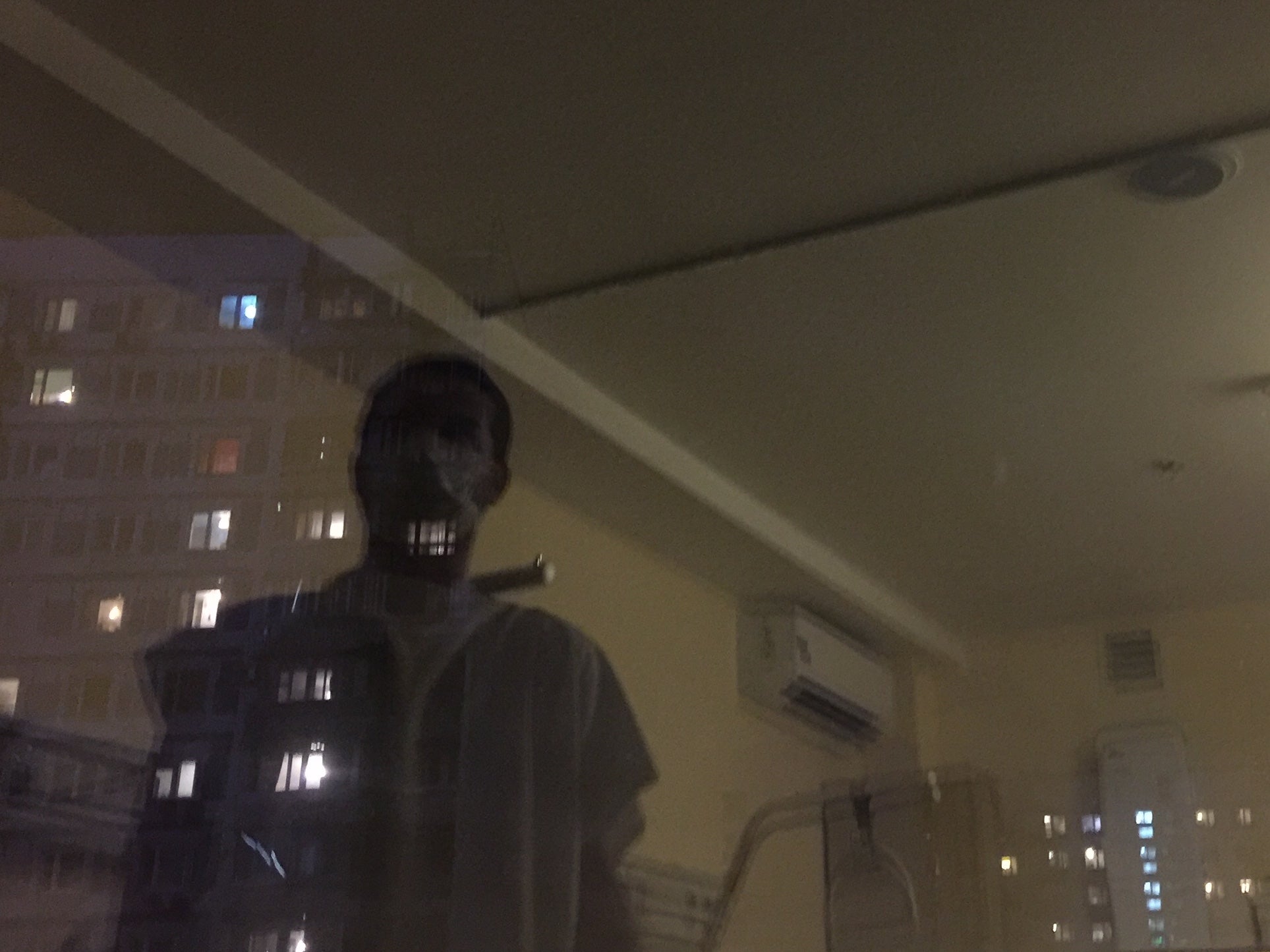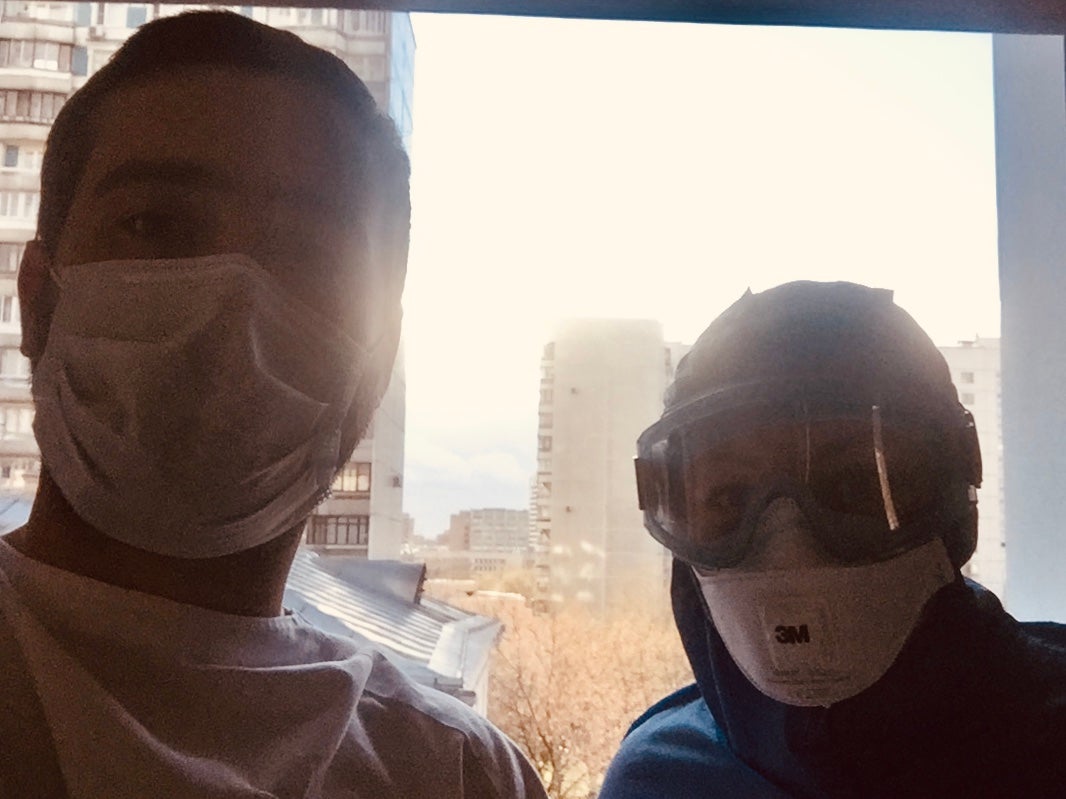Masked cosmonauts and faulty testing kits: Face to face with coronavirus on a Moscow Covid-19 ward
The Independent’s Moscow correspondent Oliver Carroll sees inside the healthcare machinery fighting Russia’s spiralling coronavirus outbreak, where according to officials 90 per cent of new patients are aged 65 or under


Seeing the cosmonauts in white suits standing in the void behind the plexiglass doors was the moment it hit.
In time, I would come to learn the names of the doctors and nurses. But for now, in the pitch black, I could barely make out the human features behind their masks. The otherworldliness of it all was the only comfort in my now dawning horror of being admitted to one of Moscow’s Covid-19 red zones.
The undercover reporting assignment was, to put it mildly, unplanned. Throughout the course of the week, I’d gone through several stages of malaise: feeling peculiar, then feverish, and as fatigued as a rusty bike chain. I spoke to doctors over Skype, but they were unable to offer any clear answers. A nurse dropped by my flat to do a Covid-19 test; that came back negative. By day seven, I was coughing up blood. So I took the shallowest of deep breaths, fumbled to put on a face mask, and headed to the clinic.
Up until that point, I’d considered myself to be in good health: relatively young, fit, and clean-living. Sickness wasn’t something I seriously considered, less so a disease supposed to target the old and chronically ill. For their part, doctors were also confused by what they saw. Diagnostic tests were contradictory. There were some markers of the virus, but chest scans were at this point clear. The only real evidence pointed to a bacterial lung infection.
But Andrei Tikhov, the A&E doctor who took me in, saw enough to be concerned. After administering the antibiotic azithromycin and putting me on an intravenous drip, he said I ought to be hospitalised in what I would only later understand to be a Covid-19 ward.
The hazy days that followed were to give me a unique insight into Russia’s coronavirus battle. This article is an attempt to make sense of that experience. To do justice to the personal trials of doctors and nurses as they grapple with one of the world’s worst outbreaks. To give context to the official statistics on testing, illness and mortality, which could serve a political purpose but go against doctors’ own clinical sense. And to recognise just how much we are all still to learn about Covid-19.
As Tikhov told me later, the virus doesn’t always behave as the literature says. Not everyone, for example, presents with the classic triplet of fever, shortness of breath and a dry cough. In Moscow at least, many were showing stranger, bespoke symptoms, with coughing up blood an increasingly common complaint. “There are no strict criteria when it comes to this infection,” he said. “It’s a very varied picture that’s keeping us on our toes.”
In the last few weeks, the hospital, which is one of the Russian capital’s elite private medical facilities, has reformatted several of its wards to deal with Covid-19. They’ve taken in many younger patients like me, and seen pneumonia in all age groups. It’s a picture that is mirrored across the capital. According to Russia’s own coronavirus crisis centre, 90 per cent of new patients are aged 65 or under. Some figures suggest half of those on ventilators are below the age of 40.
I was never close to such an ordeal, but my experience in the red zone was terrifying enough. I still wasn’t sure I had the virus – yet here I was, sharing a space with what Boris Johnson called the “silent mugger”. The first night, as I curled my body away from the ward in the farcical hope it would shield me from disease, I prayed the bed next to me would stay empty. From adjacent rooms, I could hear the various sounds of Covid-19 distress. In my racing imagination, death seemed to be walking up and down the corridor. It took several hours to summon up the courage to visit the loo.
The nurses would drop to do their first checks in the morning at half-past five, following sleepless nights tending to the more seriously sick. As the ward filled up, you could see exhaustion taking hold in their sallow eyes and wilting bodies. By the second day, I began to picture the personalities behind the first names that were scrawled in marker on their hazmat suits.

Occasionally, they would stop for a brief chat. I learned how many of them had been drafted in to cope with the new demand. Earning miserable salaries, they couldn’t afford to live in Moscow itself, less so to self-isolate. So instead they commuted to and from the hospital every day, hoping not to become carriers of the virus to the city outside.
There were those who were obviously haunted by the experience. Their hands trembled as they attached drips and drew blood. One nurse admitted she was terrified about bringing the virus to her family back home. I was the only patient wearing a face mask, she revealed. She was wearing her own Russian-made respirator mask as tightly as she could – even though it cut into the skin on the bridge of her nose and left significant bruising at the end of each shift.
Others showed immense courage. Elena, the nurse on duty on my second night, dismissed my glib comparisons of the pandemic to a war. “Everybody who chooses this profession has to be prepared for whatever is thrown at them,” she said. “I used to work in urology, and, believe me, I’ve seen things that are worse than the coronavirus.” She could have done with the white suits in her previous job, she added.
By the second day, thanks in no small part to the care and attention of the medical staff, I was getting better. A working theory that a secondary bacterial infection was taking hold on the back of the virus seemed to make sense. Perhaps, too, the azithromycin was having an antiviral effect as some suspected it might. But there was still no real clarity about my Covid-19 status, and doctors suggested a repeat nucleic acid test.
The procedure this time was even less dignified than the first, with nurses probing a swab down the nasal cavity as far as it could go without coming out the other side. But for all the discomfort, doctors had little expectation of a conclusive result. Sure enough, it came back negative two days later.
The mayor leading Moscow’s crisis response, Sergei Sobyanin, last week admitted tests were failing to pick up as much as 50 per cent of even the most serious hospital cases. Part of the problem is that you need sufficient virus in the upper ends of the respiratory system for the sample to be good enough. In many cases, the virus is simply off doing damage elsewhere. But there are also considerable doubts about the reliability of the Russian tests. Developed by the Vector laboratory in Siberia, a facility more commonly associated with the Soviet biological weapons programme, the test kits were introduced without any peer review or scrutiny.
Russia’s outbreak has taken off dramatically since mid-April
Pavel Loginov, the respiratory consultant with whom I spoke in the days following my discharge, told me that even 50 per cent detection rates were a massive exaggeration. Yes, some European tests were detecting over 90 per cent of infections when analysing a sample from lower down the respiratory system, he said. But the Russian tests were 10 times less accurate than that: “I’ll have twenty cases of classic Covid in front of me, and only one or two nose or throat swabs will come back positive.”
It’s an insight that offers some clues about the true size of Russia’s coronavirus outbreak. According to official figures alone, the country is now the world’s fifth-worst hit. On Wednesday, a near-record 10,559 new positive diagnoses were recorded, bringing the total number to over 165,000. If Loginov’s rule of thumb is right, upwards of 1 million Russians have been infected. Against that, Russian authorities assert that just 1,537 people have died from Covid-19, a total barely exceeding the daily combined death toll recorded by the UK at the peak of its curve.
My doctors suggested a few mitigating factors were at play locally. First, the virus seems to have affected younger populations more than in other countries, and they have correspondingly better outcomes. Second, Soviet medicine left behind a useful legacy of pandemic response, including a network of infectious disease hospitals in every region. Third, the pandemic began in Russia a month later than Europe, so there’s more know-how about what does and what doesn’t work. Doctors use ventilators more sparingly than their European counterparts did, one A&E consultant told me.
Michael Favorov, former deputy director-general at the UN’s International Vaccine Institute, also speculated that widespread immunisation against tuberculosis – and perhaps even the strain of virus circulating locally – may have had an impact.
But none of the specialists I spoke to believed in Russian miracles. Instead, they explained the exceptionally low case mortality rates by the quality of the statistics. Put simply, you can’t die from a disease if you haven’t been diagnosed with it. Unlike counterparts in Europe, Russia does not tally deaths when coronavirus is only suspected. And even if authorities aren’t actively covering up deaths, there is no push to investigate suspected Covid-19 fatalities either.
“It all depends what you are looking for,” says Loginov. “If you have someone with Covid who happens to die from cardiac arrest because of the stress, the death will almost certainly be put down to the heart.”
Only with the publication of excess mortality rates for April in the weeks to come will we have any idea of the real death rate. Before then, the weaknesses of Russia’s health system nationwide would suggest the gap between statistics and reality is only going to widen. Over its eleven time zones, Russia is a world in itself. If and when Moscow’s curve flattens, new infection spikes will almost certainly arise in other regional hubs. There, health care provision is sketchier, PPE far less available, and the fear of punishment from further up the hierarchy more acute.
As far as Moscow is concerned, a spike in infection rates beginning this weekend appears to have put paid to hopes of an imminent relaxation of the ongoing lockdown, which since 30 March has restricted residents’ rights to leave their homes for anything other than essential shopping. But the pressures to do something are mounting. A walk around the city – taking in the shuttered shops and bars and cafes – reveals the scale of the economic damage wreaked by the virus. With the government refusing to offer serious economic support, many thousands of small businesses are on the verge of collapse.
For authorities, running short of cash following an oil price crash somewhat of their own making, it is an incredibly difficult balance to strike. Yes, coronavirus is showing little sign of abating, but the risks of another disaster are getting closer. For millions of Russians, the fear is less and less about facing medical employees in cosmonaut-like white suits. It’s the prospect of not being able to put meals on plates.
Join our commenting forum
Join thought-provoking conversations, follow other Independent readers and see their replies
Comments